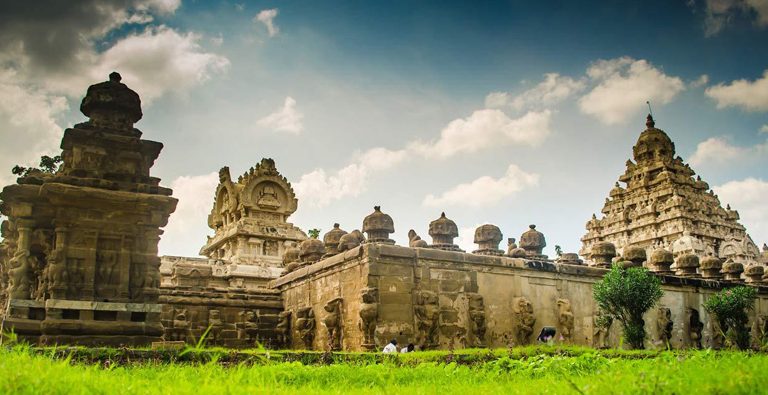Kailasanathar Temple, Kanchipuram is one of the cultural assets of India. The age-old landmark is located in Pillayarpalayam, two kilometers away from Kanchipuram City, Tamil Nadu. Apart from the famous Kanchipuram pattu (silk), the Dravidian-style temple attracts devotees as well as tourists across Tamil Nadu. Come take a look at the story behind this divine creation.
Once Upon A Time in Kanchipuram…
Kailasanathar Temple is an old temple in Kanchipuram and is dedicated to Lord Shiva. The temple envisions depict the Lord in a palace similar to his home on Mount Kailash. It is built between 685 to 705 AD. The principle shrine and the majority of the temple are built by Rajasimha Pallava. His son, Mahendravarman III completed the construction later. It is the architectural icon of the Pallava dynasty.

The inscriptions on the sculptures carved onto the walls of the temple are predominantly in Sanskrit. They talk about various philosophies of Saivism and the Pallava dynasty. There are mentions of the character traits of Rajasimha Pallava and the similarities to that of Lord Shiva. A few references from the Mahabharatha are also present.
The study of the temple by archaeologists over the years gives them enough facts to understand the history and immense culture of Kanchipuram. The inscriptions help determine the magnitude of impact the Pallava dynasty had on the town.
All About the Architecture
As the devotees enter, they first greet the huge statue of Nandi at the entrance of the temple. Luscious gardens and a temple pond add a touch of nature to the canvas of the temple.

The temple comprises various shrines devoted to Lord Shiva. The principal shrine dons a Vimana (tower) and has 9 sub-shrines surrounding it, built by Rajasimha Pallava. The smaller shrine right in front of them is built by his son, Mahendravarman III.
There are multiple smaller shrines on the inner walls of the temple which depict various forms of Lord Shiva. Murals and sculptures with engraved inscriptions adorn various parts of the temple.

To provide a strong and stable base, the use of granite is there for the foundation. The remaining components of the temple are built out of sandstone as is opposing to the other temples in Kanchipuram which are built out of hard stones.
The principal shrine chambers a Shiva Lingam made from black granite. It has 16 sided and spans to a height of 6 feet and a diameter of 3 feet. It has a circumambulatory passage surrounding the inner sanctum, which is the place of Lingam.
The Kailasanathar temple resembles the Shore temple in Mahabalipuram, by the Pallava dynasty. The former is a more intricate and refined version of the latter.
After visiting the Kailasanathar temple, the temple influences Raja Raja Cholan so much, that he builds the Brihadeeshwara temple in Tanjore. Virupaksha temple in Karnataka and the Kailasanatha temple of Ellora also draw inspiration from this architectural masterpiece.
The Highlight
/kanchipuram-temples-1221194559-2dd08ec7cfc445b3ad3e069ab7900142.jpg)
One of the most interesting features of the Kailasanathar temple is the circumambulatory passage. We can find it around the inner sanctum. The ability to complete the circumambulation determines whether or not one attains the possibility of rebirth. That passage is therefore symbolic of the cycle of birth, life, death, and rebirth.
As per mythology, Lord Vishnu took the avatar of Lord Buddha along with Narada to kill three demons. They were devotees of Lord Shiva. Later, they felt guilty and installed a Shiva Lingam to pray for forgiveness of their sins. Then Lord Shiva tells them, to wash off their sins, they will have to be reborn numerous times. Hence, they complete the circumambulation several times until they got rid of their sins.
This passage is very narrow. It is accessible by climbing a flight of stairs with seven steps. Since it is very narrow, one can only cross it by crawling. This symbolizes crawling out of the womb.
Then we reach the entrance of the passage. Everyone welcomes us to live and need to walk through the narrow passage symbolic to the hurdles we face in our life. To exit, they must go through another passage symbolic of death.
The next time you venture out to Kanchipuram, be sure to check out this beauty!
All images belong to their respective owners.


